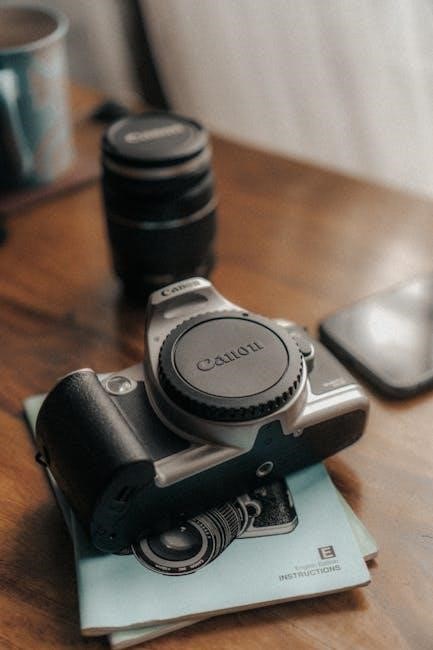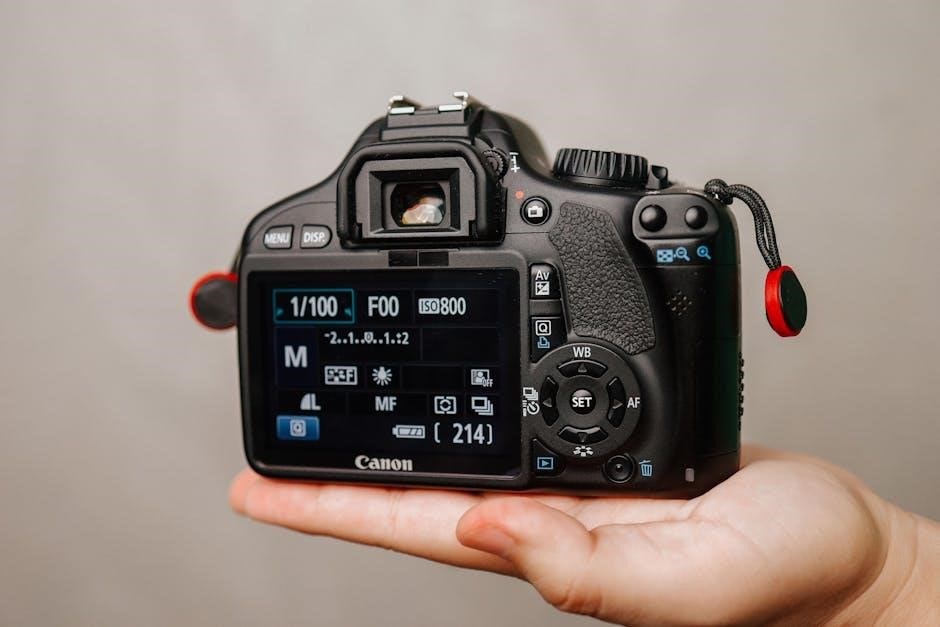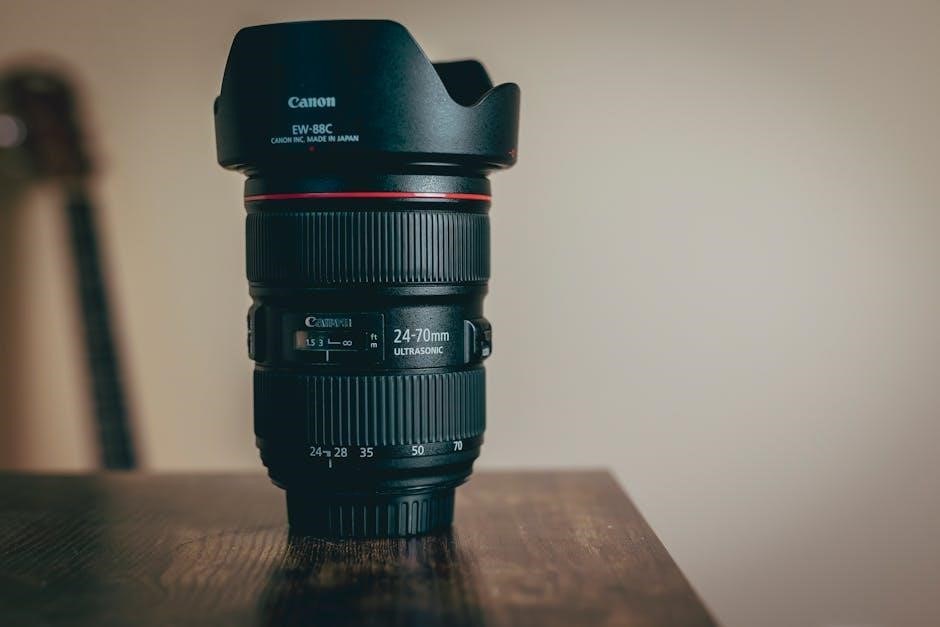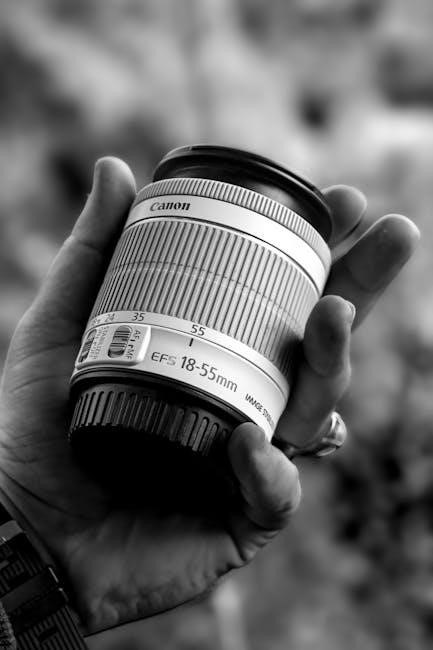canon t50 instruction manual
Lost your Canon T50 instruction manual? No worries! Get shooting amazing photos again with our easy-to-use guide. Download it now and unleash your inner photographer!
Canon T50 Instruction Manual: A Comprehensive Guide
Welcome to the comprehensive guide for the Canon T50‚ your gateway to SLR photography! This manual provides everything you need to know‚ from basic operations to advanced features‚ ensuring you capture stunning photos with ease and confidence.
The Canon T50 is an easy-to-use‚ manual focus SLR camera designed to make photography accessible. Combining built-in power winding with sophisticated electronics‚ it simplifies the picture-taking process. It’s as user-friendly as a compact camera‚ offering the flexibility of interchangeable lenses. The T50 handles exposure settings automatically‚ eliminating worries about daylight or flash photography when paired with the Canon Speedlite 244T.
While some may find its design less appealing‚ the T50 is a reliable tool for capturing great shots once you understand how to optimize its features. It’s a great starting point for those new to SLR photography‚ providing a blend of simplicity and professional-looking results. Whether you’ve rediscovered one or are just starting‚ this guide will help unlock its potential.
Key Features of the Canon T50
The Canon T50 boasts several key features that make it a standout SLR camera. Primarily‚ it offers automatic exposure control‚ simplifying the process of capturing well-lit images. The built-in power winding mechanism automatically advances the film after each shot‚ allowing for continuous shooting without manual winding. This feature enhances the user experience‚ making it easier to focus on composition and timing.
Furthermore‚ the T50 utilizes the Canon FD lens mount‚ providing access to a wide array of interchangeable lenses. These lenses offer versatility in focal length and aperture‚ enabling photographers to adapt to various shooting scenarios. The combination of automatic features and lens flexibility makes the T50 a capable and user-friendly camera.
Automatic Exposure Control
The Canon T50’s automatic exposure control is a cornerstone of its user-friendly design. This feature eliminates the need for manual adjustments of aperture and shutter speed in most situations. The camera automatically selects the optimal settings based on the available light‚ ensuring properly exposed images. This is particularly beneficial for beginners who may be unfamiliar with the intricacies of manual exposure.
The T50’s program mode simplifies the shooting process‚ allowing users to concentrate on composition and capturing the moment. While offering ease of use‚ it still delivers excellent results in various lighting conditions. This automatic system makes the Canon T50 an accessible entry point into the world of SLR photography.
Built-in Power Winding
The Canon T50 boasts a built-in power winding mechanism‚ a significant feature that automates film advancement after each shot. This eliminates the need for manual film winding‚ streamlining the shooting process and allowing photographers to focus on capturing the perfect moment. The power winder advances the film swiftly and reliably‚ ensuring you’re always ready for the next shot.

This feature enhances the overall shooting experience‚ especially when capturing fast-paced action or a series of quick shots. The convenience of automatic film winding contributes to the T50’s ease of use‚ making it an excellent choice for both beginners and experienced photographers seeking a hassle-free shooting experience. It operates efficiently‚ ensuring smooth and consistent film advancement.

Interchangeable Lens System (FD Lenses)
The Canon T50 utilizes the Canon FD lens mount‚ offering access to a wide array of interchangeable lenses. This system empowers photographers with creative flexibility‚ allowing them to adapt to various shooting scenarios and achieve diverse visual effects. FD lenses are known for their quality optics and robust construction‚ providing excellent image sharpness and clarity.
Whether you’re capturing landscapes‚ portraits‚ or close-up shots‚ the FD lens system provides the tools to realize your creative vision. Experiment with different focal lengths and apertures to control depth of field and perspective. The ability to change lenses elevates the T50 beyond a simple point-and-shoot camera‚ offering a gateway to more advanced photographic techniques and artistic expression. The FD mount ensures compatibility with a broad range of Canon’s legacy lenses.
Getting Started with the Canon T50
Embarking on your photographic journey with the Canon T50 begins with a few essential steps. Firstly‚ familiarize yourself with the camera’s basic components and controls. Understanding the location and function of the shutter release‚ film advance‚ and lens mount is crucial for smooth operation; Next‚ ensure you have the necessary batteries to power the camera’s built-in mechanisms‚ including the automatic film winding system.
Before you can start taking photos‚ you’ll need to load a roll of film into the camera. This process involves carefully opening the camera back‚ inserting the film cartridge‚ and threading the film leader onto the take-up spool. Proper film loading is essential to prevent light leaks and ensure the film advances correctly after each shot. This section will guide you through each step‚ providing clear instructions and helpful tips for a seamless start.
Battery Installation and Usage
Powering your Canon T50 is crucial for its operation‚ particularly for the automatic film winding and electronic functions. The T50 requires two AA batteries‚ which are housed in the battery compartment typically located at the camera’s base. To install the batteries‚ carefully open the compartment using a coin or screwdriver‚ ensuring you align the positive (+) and negative (-) terminals correctly as indicated inside the compartment.
Proper battery installation is key to preventing malfunctions. Once the batteries are in place‚ close the compartment securely. The camera should now power on‚ indicated by the readiness light in the viewfinder. Regularly check the battery level and replace the batteries when the indicator shows low power or the film winding becomes sluggish. Using high-quality alkaline batteries will ensure reliable performance and extend the camera’s operational life.
Loading Film
Loading film into your Canon T50 is a straightforward process that ensures you’re ready to capture memories. Begin by opening the camera back‚ typically done by lifting the film rewind knob or using a designated latch. With the back open‚ insert a fresh roll of 35mm film into the film chamber‚ pushing it in until it sits securely. Next‚ pull the film leader across the camera body to the take-up spool.

Insert the film leader into one of the slots on the take-up spool‚ ensuring it catches properly. Gently advance the film using the film advance lever‚ watching to see that the film sprockets engage with the film perforations. Close the camera back and continue advancing the film until the frame counter displays “1.” Your Canon T50 is now loaded and ready to shoot!
Basic Operation: Taking Photos
Taking photos with your Canon T50 is designed to be simple and enjoyable‚ even for beginners. The T50 primarily operates in programmed automatic exposure mode‚ meaning the camera selects the optimal aperture and shutter speed for you. To begin‚ ensure your camera has batteries installed and film loaded. Compose your shot by looking through the viewfinder‚ paying attention to the scene’s elements and how they interact within the frame.
Next‚ gently press the shutter release button halfway down to activate the metering system. The camera will assess the light and set the appropriate exposure. Once the image is in focus (using manual focus)‚ press the shutter release button fully to capture the photo. The built-in power winding system will automatically advance the film to the next frame. Repeat these steps for each photo you wish to take‚ making sure to explore different compositions and subjects.
Setting the Program Mode
The Canon T50 simplifies photography with its programmed automatic exposure. To engage this mode‚ ensure that the lens’s aperture ring is set to the “A” position. This signifies that the camera‚ and not the user‚ will control the aperture based on its light metering. The T50 is designed to work primarily in this automatic mode‚ making it easy for beginners to achieve well-exposed photos without manually adjusting settings.
With the lens set to “A‚” the camera will analyze the scene’s brightness and automatically select the appropriate aperture and shutter speed combination for optimal exposure. There is no need to manually set either parameter. Simply point‚ focus‚ and shoot. This feature allows you to concentrate on composition and capturing the moment‚ rather than worrying about technical details. This ease of use makes the T50 an excellent choice for those new to SLR photography.
Focusing Manually
Despite its automatic features‚ the Canon T50 requires manual focusing‚ giving you control over sharpness. Look through the viewfinder and locate the focusing screen‚ typically featuring a microprism collar or split-image rangefinder in the center. Rotate the focusing ring on your lens until the image in the focusing aid appears sharp and clear.
For subjects with fine details‚ the microprism collar will show a clear image when properly focused. With a split-image rangefinder‚ lines will align when the subject is in focus. Accurate focusing is crucial for sharp images‚ especially in low light or with shallow depths of field. Practice focusing on various subjects at different distances to develop your skill. This manual process offers a tactile and engaging experience.

Using the Shutter Release
The shutter release button on your Canon T50 is your gateway to capturing moments. To take a photo‚ gently press the shutter release halfway down to activate the light meter and allow the camera to determine the appropriate exposure settings. Ensure your subject is properly focused before proceeding.

Once you are ready‚ smoothly press the shutter release button fully down to take the picture. Avoid jerky movements‚ as this can cause camera shake and result in blurry images. After the photo is taken‚ the built-in power winding mechanism will automatically advance the film to the next frame‚ readying the camera for your next shot. With practice‚ using the shutter release will become second nature‚ allowing you to focus on composition and capturing the perfect moment.
Advanced Features and Tips
While the Canon T50 is known for its simplicity‚ it also offers features that can elevate your photography. Understanding these can help you move beyond basic point-and-shoot operation and unlock your creative potential. Experiment with different compositions‚ explore various lighting conditions‚ and don’t be afraid to try new things.
Consider using filters to enhance your images‚ such as a polarizing filter to reduce glare or a neutral density filter to allow for longer exposures. Pay attention to the light and how it affects your subject. By mastering these advanced techniques‚ you’ll be able to capture truly stunning and unique photographs with your Canon T50. Embrace the learning process and enjoy the journey of photographic discovery!
Using the Canon Speedlite 244T Flash
The Canon Speedlite 244T is designed specifically for the Canon T series cameras‚ offering seamless integration and automatic flash exposure. Attach the flash to the hot shoe on top of the camera. Ensure it clicks securely into place. Turn on the Speedlite 244T; it’s ready when the ready light illuminates.
The T50 will automatically set the appropriate aperture for flash photography. Refer to the flash’s guide number and film speed to determine the effective range. For optimal results‚ keep your subject within this range. The 244T significantly enhances low-light performance‚ allowing you to capture well-lit images even in dark environments. Remember to conserve battery power by switching off the flash when not in use.
Understanding Exposure Compensation (If Applicable)
Exposure compensation allows you to override the camera’s automatic exposure settings‚ making your images brighter or darker. While the Canon T50 primarily operates in program mode‚ understanding exposure compensation is crucial for tricky lighting situations. This feature is beneficial when shooting subjects that are significantly brighter or darker than the background.
If your T50 model has an exposure compensation dial‚ rotating it towards the plus (+) side will increase exposure‚ brightening the image. Conversely‚ rotating it towards the minus (-) side will decrease exposure‚ darkening the image. Use exposure compensation to prevent underexposure in bright scenes‚ such as snow or sand‚ and overexposure in dark scenes. Experiment to achieve desired results.

Troubleshooting Common Issues
Encountering issues with your Canon T50? Let’s troubleshoot! If the camera fails to power on‚ ensure the batteries are correctly installed and have sufficient charge. A common problem is film not advancing; check if the film is loaded properly and the take-up spool is engaged. If your images are consistently over or underexposed‚ examine the lens for smudges or obstructions.

If the built-in power winding malfunctions‚ try replacing the batteries‚ as weak batteries can cause winding problems. For blurry images‚ ensure you’re focusing correctly‚ especially in manual focus mode. Should the flash not fire‚ confirm it’s securely attached and charged; Always consult your manual for specific error codes or detailed solutions.

Maintenance and Care
Proper maintenance ensures your Canon T50’s longevity. Regularly clean the lens with a soft‚ lint-free cloth to remove dust and fingerprints‚ avoiding harsh chemicals. Store the camera in a cool‚ dry place with the lens cap on to prevent damage from moisture and dust. Periodically check the battery compartment for corrosion‚ cleaning it gently if necessary to maintain good contact.

Avoid exposing the camera to extreme temperatures or humidity‚ which can harm its electronic components. If you won’t be using the T50 for an extended period‚ remove the batteries to prevent leakage. Handle the camera with care to prevent impacts or drops that could damage internal mechanisms. This simple care helps keep the T50 working.
Where to Find the Manual
Finding a Canon T50 instruction manual is easier than you might think! Several online resources offer PDF downloads of the original manual‚ providing detailed guidance on operating the camera. Websites dedicated to camera manuals often have a scanned version available for free. Additionally‚ online forums and communities dedicated to vintage cameras may have members who can provide a copy or direct you to one.
Keep an eye on online auction sites or used book retailers for printed manuals. Though they may be pre-owned‚ these physical copies can be a valuable addition to your camera kit‚ especially for collectors or those who prefer a tangible guide. Remember to verify the manual’s condition before purchasing.
Online PDF Downloads
Several websites offer free PDF downloads of the Canon T50 instruction manual. These digital versions are a convenient way to access the manual on your computer‚ tablet‚ or smartphone. A quick online search for “Canon T50 manual PDF” will yield numerous results. Look for reputable websites specializing in camera manuals or documentation. Websites dedicated to camera repair and service often host these manuals as well.
Before downloading‚ ensure the file is from a trustworthy source to avoid potential malware or viruses. Once downloaded‚ you can easily search for specific topics or print out relevant sections for on-the-go reference while using your Canon T50.
Printed Manual Availability
While online PDF downloads are readily available‚ some users prefer the tactile experience of a printed manual. Finding an original printed Canon T50 instruction manual can be challenging‚ as the camera was produced from 1983 to 1989. However‚ several avenues exist for acquiring a physical copy.
Online marketplaces like eBay and Etsy often have listings for used manuals. Be sure to carefully review the seller’s description and photos to assess the manual’s condition. Some camera shops or vintage camera dealers may also have original or reproduction manuals available. Additionally‚ professionally bound‚ high-quality black-and-white reproduction manuals are sometimes offered online‚ providing a more durable and legible alternative to a used original.

